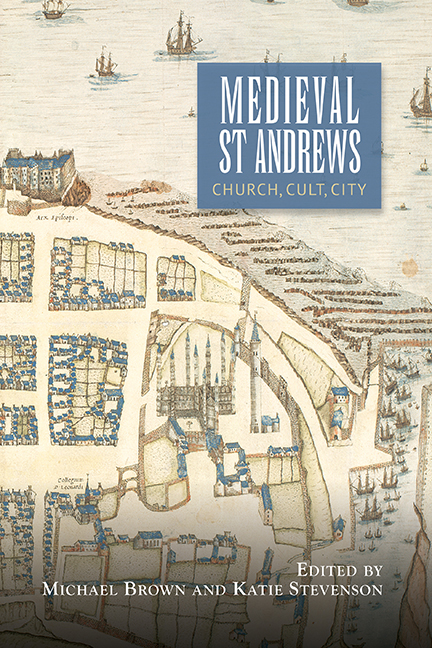Book contents
- Frontmatter
- Dedication
- Contents
- List of Illustrations, Charts and Tables
- Contributors
- Abbreviations
- 1 ‘Ancient Magnificence’: St Andrews in the Middle Ages: An Introduction
- 2 From Cinrigh Monai to Civitas Sancti Andree: A Star is Born
- 3 The Idea of St Andrews as the Second Rome Made Manifest
- 4 The Medieval Ecclesiastical Architecture of St Andrews as a Channel for the Introduction of New Ideas
- 5 When the Miracles Ceased: Shrine and Cult Management at St Andrews and Scottish Cathedrals in the Later Middle Ages
- 6 Religion, Ritual and the Rhythm of the Year in Later Medieval St Andrews
- 7 Living in the Late Medieval Town of St Andrews
- 8 The Burgh of St Andrews and its Inhabitants before the Wars of Independence
- 9 The Archaeology of Medieval St Andrews
- 10 Prelates, Citizens and Landed Folk: St Andrews as a Centre of Lordship in the Late Middle Ages
- 11 Augmenting Rentals: The Expansion of Church Property in St Andrews, c. 1400–1560
- 12 The Prehistory of the University of St Andrews
- 13 University, City and Society
- 14 The Medieval Maces of the University of St Andrews
- 15 Heresy, Inquisition and Late Medieval St Andrews
- Appendix 1 The St Andrews Foundation Account
- Appendix 2 The Augustinian' Account
- Appendix 3 The Boar' Raik
- Appendix 4 University of St Andrews Library, UYSL 110/6/4
- Index
- Miscellaneous Endmatter
13 - University, City and Society
Published online by Cambridge University Press: 28 April 2017
- Frontmatter
- Dedication
- Contents
- List of Illustrations, Charts and Tables
- Contributors
- Abbreviations
- 1 ‘Ancient Magnificence’: St Andrews in the Middle Ages: An Introduction
- 2 From Cinrigh Monai to Civitas Sancti Andree: A Star is Born
- 3 The Idea of St Andrews as the Second Rome Made Manifest
- 4 The Medieval Ecclesiastical Architecture of St Andrews as a Channel for the Introduction of New Ideas
- 5 When the Miracles Ceased: Shrine and Cult Management at St Andrews and Scottish Cathedrals in the Later Middle Ages
- 6 Religion, Ritual and the Rhythm of the Year in Later Medieval St Andrews
- 7 Living in the Late Medieval Town of St Andrews
- 8 The Burgh of St Andrews and its Inhabitants before the Wars of Independence
- 9 The Archaeology of Medieval St Andrews
- 10 Prelates, Citizens and Landed Folk: St Andrews as a Centre of Lordship in the Late Middle Ages
- 11 Augmenting Rentals: The Expansion of Church Property in St Andrews, c. 1400–1560
- 12 The Prehistory of the University of St Andrews
- 13 University, City and Society
- 14 The Medieval Maces of the University of St Andrews
- 15 Heresy, Inquisition and Late Medieval St Andrews
- Appendix 1 The St Andrews Foundation Account
- Appendix 2 The Augustinian' Account
- Appendix 3 The Boar' Raik
- Appendix 4 University of St Andrews Library, UYSL 110/6/4
- Index
- Miscellaneous Endmatter
Summary
NO study of late medieval St Andrews would be complete without due consideration of the foundation and development of its university. Elsewhere in this volume Norman Reid explores the prehistory of higher learning in St Andrews and the complex circumstances of the establishment of a studium generale in the city in the years leading up to 1413. This chapter focuses rather on its subsequent development until the Reformation of 1560 and the foundation of its constituent colleges of St Salvator's (1450), St Leonard's (1512) and St Mary's (1538/54). As well as considering its internal evolution, however, what follows places the university in wider national and international contexts, looking at St Andrews’ relations with subsequent Scottish university foundations at Glasgow (1451) and King's College, Aberdeen (1495) against a backdrop of what amounted to a revolution in European educational provision in the long fifteenth century. The sources for the study of St Andrews in this period are scrappy and limited, but sufficient records survive to allow us to offer some assessment of the university's impact on Scotland's ecclesiastical capital, while also considering the ramifications for the Scottish kingdom of the establishment of its first such centre of learning.
As Norman Reid makes clear, the absence of a university in Scotland before 1413 does not mean the absence of higher education. Many of the religious houses that had been founded in the twelfth and thirteenth centuries, not least the Augustinian priory attached to St Andrews’ Cathedral, were centres of learning with substantial libraries that provided education to a high level. Scots also, and famously, joined the ranks of the wandering scholars who sought education abroad, at Paris in particular, the greatest of the northern European universities, but also at Orléans (where, unlike at Paris, civil law was taught and where, uniquely, a formal Scottish ‘nation’ was established) and Montpellier (the major centre for the study of medicine). The foundation of three universities in Scotland in the fifteenth century did not put an end to this academic diaspora. Few Scots scholars attended the two English centres of learning at Oxford and Cambridge, dating from the twelfth and early thirteenth centuries, though both also experiencing substantial expansion in the era discussed here.
- Type
- Chapter
- Information
- Medieval St AndrewsChurch, Cult, City, pp. 268 - 297Publisher: Boydell & BrewerPrint publication year: 2017

